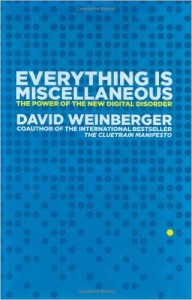Book Review: Everything is Miscellaneous by David Weinberger
 Everything is Miscellaneous: The Power of the New Digital Order by David Weinberger (2007) is a call to arms in defense of the seeming chaos that is the digital world. Weinberger describes the first, second, and third order of classifications that have evolved in the field of information science. The benefits of the third, digital order outweighs the need for clear cut organization for our business, learning, and social lives online and radically changes the way people interact with the information of their lives.
Everything is Miscellaneous: The Power of the New Digital Order by David Weinberger (2007) is a call to arms in defense of the seeming chaos that is the digital world. Weinberger describes the first, second, and third order of classifications that have evolved in the field of information science. The benefits of the third, digital order outweighs the need for clear cut organization for our business, learning, and social lives online and radically changes the way people interact with the information of their lives.
Starting with the Dewey Decimal system and other attempts at bringing organization to the physical, we try to impress order upon large collections of objects so that they may be found again when needed. The Bettmann Archive of 11 million photographs and negatives lives in underground storage, physically organized chronologically. This is the first order and is limited by physical constraints of the world: an object can exist in one place at a time, the height of shelves, proximity to related things, etc.
The second order of classification, a card catalog in the case of the Bettmann Archive, separates the information about the objects into a compact format that can be referenced as a finding aide. The benefit to this system is that searching is done from one location instead of handling every object. The limitations of the second order is that information gets truncated and streamlined to be a good representation. This means that some information gets left out since you can’t write the whole book on a catalog card. Once you find the subject you want, an expert is still needed to sort through the boxes to find your specific request.
The third, digital order allows for infinite forms of classification and organization. Weinberger uses the stock photography company Corbis as a contemporary comparison (and parent company) to the Bettmann Archive. The millions of images, that exist digitally, in Corbis holdings can be searched by subject and a number of sub categories, all online. Any image can be found in seconds by customers. This is the way of the digital order.
Weinberger takes this idea of infinite classification even further in describing how Flickr.com, a social photo sharing site, allows users to tag photos with whatever words and groups they wish. Called social tagging, this uncontrolled vocabulary adds user defined and relevant metadata to the photo for finding later. This context is added in addition to EXIF data, or the technical metadata that comes from the camera. This creates a messy, but incredibly fruitful way of connecting images in any multitude of relationships. Taxonomies, while varied, become stronger and more accurate the more they are used. Durrance and Fisher’s definition of Information Communities (2003) state that information communities form around people’s information needs, emphasize collaboration around diverse information providers, and take advantage of technology. Social tagging contributes to all of these things in addition to transcending barriers of information sharing because it is user generated meaning. (pp. 3-5)
A descendent of Flickr, Instagram is another example of how social tagging and user context creates findability for images. The “tags” from Flickr manifest as “hashtags” on Instagram. Again, the user annotates an image with contextual clues so that like minded people may find and see their photos. A tag for a specific location might take form in different ways: #losangeles #LA #dtla #cityofangeles #insta_losangeles #ilovela. The more a tag is used, the more people see it and adopt its use. When typing a tag into the app a list pops up with suggestions and the number of posts that use it, so a user can judge how popular a certain tag is. Unless a tag is used in a syntactical way as part of a caption, most people would choose to use the most popular tag for findability. Couple this with clustering, machine learning, algorithms built to recognize synonyms and relationships, and other contextual clues, relevant information can be pulled easily from the massive data dump that is the internet.
This bottom up taxonomy while seemingly chaotic is a useful tool considering the volume of uploads every day and the diversity of users. It affects many different communities as they search for information online. There is a case to be made that the miscellany of the digital order creates a more democratic access to information – both creation and consumption. (Manovich) We now have the power to customize our information and search it from any angle of our choosing, not strictly within a codified structure of someone else’s making.
Reference List:
Fisher, K., & Durrance, J. (2003). Information communities. In K. Christensen, & D. Levinson (Eds.), Encyclopedia of community: From the village to the virtual world. (pp. 658-661). Thousand Oaks, CA: SAGE Publications, Inc. Retrieved from http://libaccess.sjlibrary.org/login?url=http://knowledge.sagepub.com/view/community/n248.xml
Manovich, L. (2016, February 13). Mainfesto for democratic art history. [Web log post]. Retrieved from http://lab.softwarestudies.com/2016/02/manifesto-for-democratic-art-history.html
Weinberger, D. (2007) . Everything is miscellaneous: The power of the new digital disorder. New York, NY: Henry Holt.
Tagged with: books, Flickr, images, Instagram, metadata, MLIS, review
Category: Reading
Write a Reply or Comment
You must be logged in to post a comment.